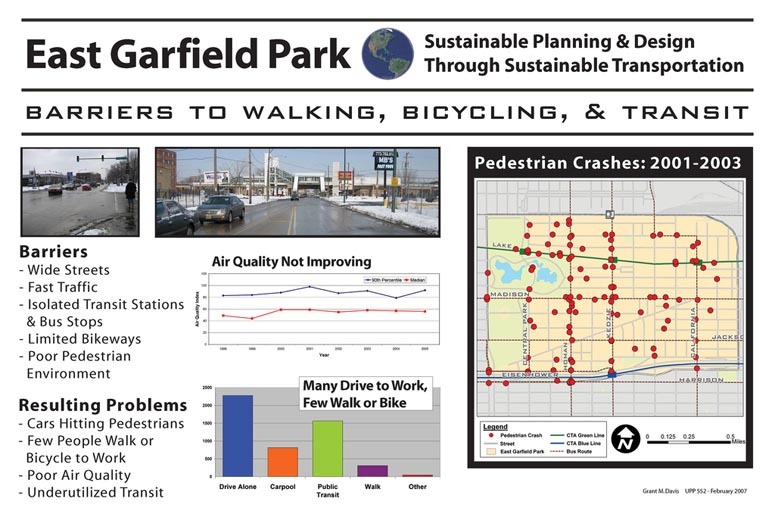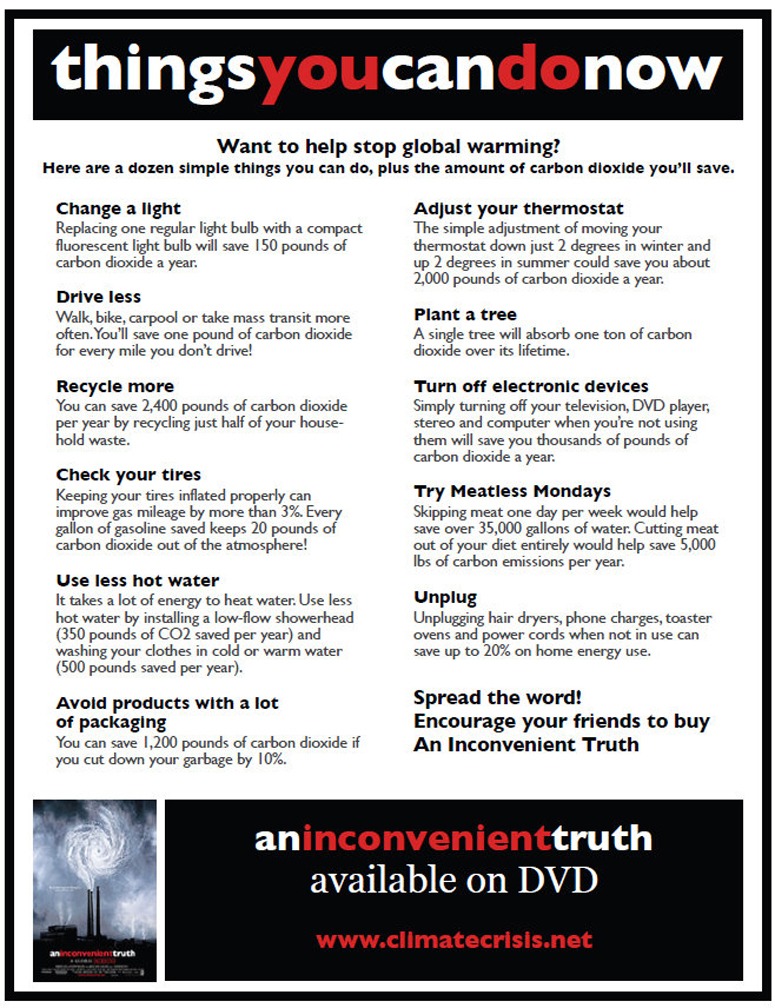Watching Al Gore’s Inconvenient Truth at one sitting led me to the following conclusions:
- The film is excellent and has much to teach college lecturers, both about the analysis of complex issues and about the the use of words & images in presenting an argument.
- Gore’s argument is weakened by his homepage link to a Buy Now button on climatecrisis.net – regardless of how he shares the profits. It makes him seem like a greedy evangelist on TV.
- Gore’s list (below) of Thing’s You Can Do Now, is ultra-trivial and may have set back the cause by encouraging politicians to believe that little change is necessary. The film mentions population growth but it is not on the list, doubtless for ‘political’ reasons.
- The best commentary on the issues comes from Justice Burton. He said the film is ‘broadly accurate’ but listed nine inaccuracies
- A landscape approach to urban design can do more to combat climate change than Al Gore can imagine. We can and should:
- use all roofspace: for vegetation, gardens, power generation or the daylighting of interior space
- plan cities for extensive use of human-powered and solar-powered transport (above image courtesy TouringCyclist) – but see my recent post on White Commuting
- compost as much as possible within the boundaries of each and every property
- infiltrate as much water as possible within the boundaries of each and every property
- make all buildings energy efficient, by orientation, vegetation, insulation, durability, daylighting, avoidance of lifts and escalators etc
- design new homes so they can become home offices, when eCommuting becomes the norm, with a smooth transition from indoor to outdoor spaces with differential climatic and temperature characteristics
For landscape architects and urban designers thinking about new jobs and professional opportunities in sustainable urban design, the above are very convenient truths.
Another ‘inconvenient truth’ ignored by Gore, is that the environmental impact of bottled water has been calculated, by SGWA, to be 1000 times greater than that of tap water. So ban it, as a small town in Australia has done: Bundanoon, in New South Wales. Perhaps the American language needs a new word: an ‘ingored truth’



The normal winter temperature in my home office is 15 degrees celsius. Does this mean I am breaking the law: http://www.hse.gov.uk/contact/faqs/temperature.htm “The temperature in workrooms should normally be at least 16 degrees Celsius unless much of the work involves severe physical effort in which case the temperature should be at least 13 degrees Celsius.”
The task being undertaken, the equipment being used, the difference between indoor and outdoor temperatures, heat generated from 1) equipment 2) people 3) processes in the room, the location of the room in the building, relative humidity and ventilation and dare I say it the health and fitness and physiology of the person and their acclimatisation to particular climatic conditions
[ http://physiotherapy.curtin.edu.au/resources/educational-resources/exphys/00/heat.cfm%5D etc etc all contribute to comfort in a work environment. ]
The law in this situation is probably attempting to cover minimums to suit a percentile range of the population. (Perhaps 85?). As with fashion (clothing sizes) as the population demographics shifts so does the accuracy of the percentiles! [ http://www.ergonomics4schools.com/lzone/anthropometry.htm ]
Are you breaking the law? I suppose there would be a test of reasonableness to be applied.
(1) I think my workplace temperature is one of the many occasions on which it is necessary, in the interests of sustainability, to break the law and take the consequences (am I right in associating this principle with Sir Thomas More?). (2) Another is the need to ignore red traffic lights IF AND ONLY IF there is no danger to other road users and increased safety for the cyclist. We cannot encourage green transport by making cycling slower and more dangerous than it need be. (3) A third example is that 30 years ago we were told by a municipal engineer that it is ILLEGAL to discharge rain water from the roof into the soil of our garden. He said it was sewage and that sewage must go into drains.
(1) I think the principle of breaking the law and taking the consequences is actually similar to conscientious objectors (ie. Vietnam). Thomas More rather than break the law kept quiet. [ http://www.sparknotes.com/lit/amanforallseasons/summary.html ]
(2) I am still in favour of a cycle tube which would be usable in all seasons and allow a free flow of cycle traffic at speeds most suited to cycling. Perhaps a traffic management (signalling system) would be necessary?
(3) Yes thinking changes. It seems that water is now being coded according to the way it impacts on the environment: blue, green and grey. [ http://www.worldchanging.com/archives/004494.html ] I would be for adding white (treated drinking water) and black (de-saltinated water)water to the list.
A wonderful aspect of cycle tubes is that each cyclist’s physical effort assits the transit of other cyclists by sustaining a flow of air in the tube. The tube therefore becomes a community project. You help me; I help you; we all help save the planet – and far more effectively than politicians in Kyoto or Copenhagen, with their ideas for enriching brokers by cap and trade.
Yes re conscientious objectors – and it may be that I picked up the idea from reading Bertrand Russell in my teens. I also have a tendency to muddle my Thomases (More, Cromwell and Cranmer, not to mention Beckett and Judas) who died with concerns about the law and their principles. Cranmer put it like this: ‘And now I come to the great thing that troubleth my conscience more than any other thing that ever I said or did in my life: and that is, the setting abroad of writings contrary to the truth. Which here now I renounce and refuse, as things written with my hand contrary to the truth which I thought in my heart, and writ for fear of death, and to save my life, if it might be: and that is, all such bills, which I have written or signed with mine own hand, since my degradation; wherein I have written many things untrue. And forasmuch as my hand offended in writing contrary to my heart, therefore my hand shall first be punished. For if I may come to the fire, it shall be first burned. And as for the Pope, I refuse him, as Christ’s enemy and antichrist, with all his false doctrine.’ http://www.luminarium.org/renlit/cranmerspeech.htm
Perhaps we all have a moral duty to break the law by working at 15 Centigrade instead of 16 Centigrade. If we are burned at the stake for this crime, there will at least be a moment to enjoy at 20 Centigrade before things get too hot for comfort. In warmer climes, there may be a duty to perspire more, though the stake would be a less inviting prospect.
The tube therefore becomes a community project. You help me; I help you; we all help save the planet – and far more effectively than politicians in Kyoto or Copenhagen, with their ideas for enriching brokers by cap and trade.
————
Peter Fernandes